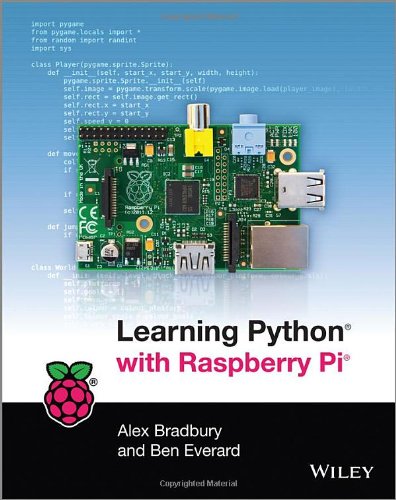| If you’ve been round here for any length of time, you’ve probably heard mention of Alex Bradbury. Alex is currently polishing off his PhD thesis at the Computer Lab at the University of Cambridge, and he’s been involved with the Raspberry Pi project as a volunteer from our very early days, back when all we had was alpha development boards. Alex is responsible for building and releasing Raspberry Pi’s Raspbian OS images, and maintaining our Debian repository in his (limited) spare time. He’s somehow also found the time to write a book with Linux Voice‘s Ben Everard. Learning Python with Raspberry Pi doesn’t presuppose any computing knowledge, and takes you from a standing start through variables, loops and functions, 3D graphical programming, building games, networking, scripting, interfacing with hardware…and, of course, Minecraft. There’s much more besides: if you work your way through the whole book you’ll be building robots and alarm systems; manipulating sound and video; and learning how to test and debug the Bradbury and Gregory way. As well as what you’ll find in the book, Alex and Ben have made a large code repository available to complement the information and instructions in Learning Python with Raspberry Pi: you’ll be able to download them free of charge. Alex says: Ever since the introduction of the Raspberry Pi, Python has been touted (with good reason) as the language of choice for anyone wanting to program on the device. Reasonable people can disagree on the ultimate reasons for Python’s success, but I think we can all recognise what an asset its large and friendly community is, as well as the value of its extensive collection of high quality libraries for helping to solve almost any programming task. Learning Python with Raspberry Pi aims to teach the reader the Python they need to make their Raspberry Pi project ideas a reality. We give lots of examples in the sort of areas likely to be of interest to the Pi community – including physical computing, audio and video, 3d graphics, Minecraft programming, and games. Another important aspect for us is that every chapter ends with a whole host of ideas and pointers on what you’re now able to do given what you’ve just learnt. Python is the single most useful language to know for the Raspberry Pi, and I like to think that with Learning Python with Raspberry Pi, we’ve managed to produce an entertaining and educational introduction to it. Hopefully you agree! Learning Python with Raspberry Pi is available from Amazon, and from a good book shop near you: we hope to be stocking it in the Swag Store soon too.
|
A Semi-automated Technology Roundup Provided by Linebaugh Public Library IT Staff | techblog.linebaugh.org
Thursday, March 27, 2014
Learning Python with Raspberry Pi
Subscribe to:
Post Comments (Atom)

No comments:
Post a Comment